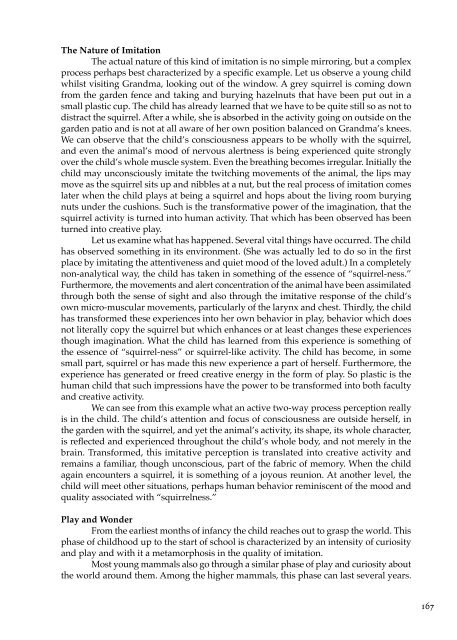The Spirit in Human Evolution - Waldorf Research Institute
The Spirit in Human Evolution - Waldorf Research Institute
The Spirit in Human Evolution - Waldorf Research Institute
Create successful ePaper yourself
Turn your PDF publications into a flip-book with our unique Google optimized e-Paper software.
<strong>The</strong> Nature of Imitation<br />
<strong>The</strong> actual nature of this k<strong>in</strong>d of imitation is no simple mirror<strong>in</strong>g, but a complex<br />
process perhaps best characterized by a specific example. Let us observe a young child<br />
whilst visit<strong>in</strong>g Grandma, look<strong>in</strong>g out of the w<strong>in</strong>dow. A grey squirrel is com<strong>in</strong>g down<br />
from the garden fence and tak<strong>in</strong>g and bury<strong>in</strong>g hazelnuts that have been put out <strong>in</strong> a<br />
small plastic cup. <strong>The</strong> child has already learned that we have to be quite still so as not to<br />
distract the squirrel. After a while, she is absorbed <strong>in</strong> the activity go<strong>in</strong>g on outside on the<br />
garden patio and is not at all aware of her own position balanced on Grandma’s knees.<br />
We can observe that the child’s consciousness appears to be wholly with the squirrel,<br />
and even the animal’s mood of nervous alertness is be<strong>in</strong>g experienced quite strongly<br />
over the child’s whole muscle system. Even the breath<strong>in</strong>g becomes irregular. Initially the<br />
child may unconsciously imitate the twitch<strong>in</strong>g movements of the animal, the lips may<br />
move as the squirrel sits up and nibbles at a nut, but the real process of imitation comes<br />
later when the child plays at be<strong>in</strong>g a squirrel and hops about the liv<strong>in</strong>g room bury<strong>in</strong>g<br />
nuts under the cushions. Such is the transformative power of the imag<strong>in</strong>ation, that the<br />
squirrel activity is turned <strong>in</strong>to human activity. That which has been observed has been<br />
turned <strong>in</strong>to creative play.<br />
Let us exam<strong>in</strong>e what has happened. Several vital th<strong>in</strong>gs have occurred. <strong>The</strong> child<br />
has observed someth<strong>in</strong>g <strong>in</strong> its environment. (She was actually led to do so <strong>in</strong> the first<br />
place by imitat<strong>in</strong>g the attentiveness and quiet mood of the loved adult.) In a completely<br />
non-analytical way, the child has taken <strong>in</strong> someth<strong>in</strong>g of the essence of “squirrel-ness.”<br />
Furthermore, the movements and alert concentration of the animal have been assimilated<br />
through both the sense of sight and also through the imitative response of the child’s<br />
own micro-muscular movements, particularly of the larynx and chest. Thirdly, the child<br />
has transformed these experiences <strong>in</strong>to her own behavior <strong>in</strong> play, behavior which does<br />
not literally copy the squirrel but which enhances or at least changes these experiences<br />
though imag<strong>in</strong>ation. What the child has learned from this experience is someth<strong>in</strong>g of<br />
the essence of “squirrel-ness” or squirrel-like activity. <strong>The</strong> child has become, <strong>in</strong> some<br />
small part, squirrel or has made this new experience a part of herself. Furthermore, the<br />
experience has generated or freed creative energy <strong>in</strong> the form of play. So plastic is the<br />
human child that such impressions have the power to be transformed <strong>in</strong>to both faculty<br />
and creative activity.<br />
We can see from this example what an active two-way process perception really<br />
is <strong>in</strong> the child. <strong>The</strong> child’s attention and focus of consciousness are outside herself, <strong>in</strong><br />
the garden with the squirrel, and yet the animal’s activity, its shape, its whole character,<br />
is reflected and experienced throughout the child’s whole body, and not merely <strong>in</strong> the<br />
bra<strong>in</strong>. Transformed, this imitative perception is translated <strong>in</strong>to creative activity and<br />
rema<strong>in</strong>s a familiar, though unconscious, part of the fabric of memory. When the child<br />
aga<strong>in</strong> encounters a squirrel, it is someth<strong>in</strong>g of a joyous reunion. At another level, the<br />
child will meet other situations, perhaps human behavior rem<strong>in</strong>iscent of the mood and<br />
quality associated with “squirrelness.”<br />
Play and Wonder<br />
From the earliest months of <strong>in</strong>fancy the child reaches out to grasp the world. This<br />
phase of childhood up to the start of school is characterized by an <strong>in</strong>tensity of curiosity<br />
and play and with it a metamorphosis <strong>in</strong> the quality of imitation.<br />
Most young mammals also go through a similar phase of play and curiosity about<br />
the world around them. Among the higher mammals, this phase can last several years.<br />
167
















